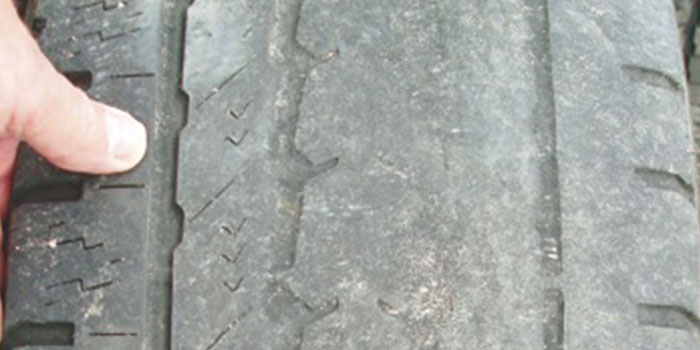Modern tire construction has generally trended toward low aspect ratio tire casings with more flexible sidewalls and rigid treads. Although this type of construction has made tires less sensitive to negative camber angles used in many current steering geometry designs, many types of tire wear patterns continue to indicate problems in a vehicle’s steering geometry.
To illustrate, many import manufacturers have eliminated adjustable camber and caster alignment angles from their suspensions. Consequently, it’s doubly important to recognize signs of tire wear caused by bent struts, spindles, steering knuckles and control arms. See Photo 1.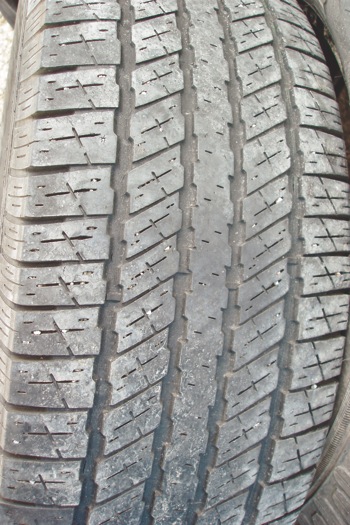
CAMBER ANGLES
To better understand how bent steering components affect tire wear, let’s draw an imaginary line front to rear, through the center of the vehicle chassis. Positive camber is represented by the top of the tire leaning away from the centerline, while the top of the tire leaning toward the centerline represents negative camber. Thanks to advanced tire designs, many modern vehicles improve handling by incorporating negative camber into their suspension designs.
When diagnosing steering-pull complaints, remember that camber pulls toward the front tire with the most positive camber angle. Remember, too, that changes in camber angle are most affected by changes in the vehicle’s ride height. See Photo 2.
STEERING AXIS INCLINATION (SAI)
SAI reduces steering effort and improves steering response by allowing the tire to pivot at the centerline of the tire tread. SAI, along with caster angle, also helps center the steering wheel after cornering. SAI is best represented by drawing a line through the upper and lower pivot points (ball joints) of the steering knuckle through the approximate center of the tire tread.
To improve steering response as the vehicle navigates a corner, SAI also operates in concert with caster angle to increase the inside wheel positive camber and decrease the outside wheel positive camber. When diagnosing a camber-related tire wear complaint, it’s also important to know that incorrect SAI caused by a bent spindle or strut will negatively affect camber angle during cornering.
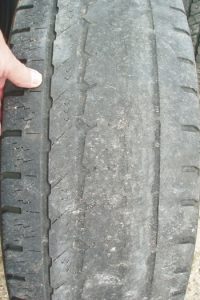 SAI is most affected by offset wheel rims because offset wheels move the tires away from their normal pivot centers. Many undesirable issues are therefore created by offset wheels, including excessive negative camber wear, increased steering effort and increased steering sensitivity to road surface irregularities.
SAI is most affected by offset wheel rims because offset wheels move the tires away from their normal pivot centers. Many undesirable issues are therefore created by offset wheels, including excessive negative camber wear, increased steering effort and increased steering sensitivity to road surface irregularities.
The effects of SAI are most notable on open-tread, off-road tires because the camber change through a turn is often sufficient to wear the corners off the tread blocks. This condition often can’t be avoided with some types of 4WD vehicles equipped with solid front axles. Since SAI is a fixed angle built into the spindle, SAI-related tire wear complaints are generally caused by offset wheels and bent spindles. See Photo 3.
CASTER ANGLE
Positive caster angle is represented when the upper pivot point or ball joint of the steering knuckle trails behind the lower pivot point or ball joint. To better clarify, always remember that any bicycle has positive caster built into its steering fork.
In most cases, modern vehicles incorporate relatively large amounts of positive caster to help center the steering wheel during forward driving, and to also enhance steering geometry when driving around a corner.
Unlike camber, caster angle isn’t significantly changed by vehicle ride height and, except in the most extreme cases, does not affect tire wear.
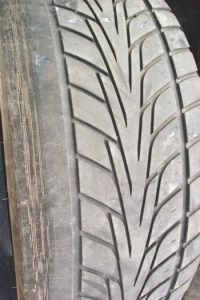 TOE ANGLE
TOE ANGLE
Positive toe angle is represented when the front wheels point to the forward centerline of the vehicle. Positive toe is commonly used on rear-wheel-drive (RWD) vehicles to compensate for the outward deflection in the steering linkage created by the rolling resistance of the tires.
In contrast, negative toe angle is used on many front-wheel-drive (FWD) vehicles to compensate for the positive toe angle created by the forward driving thrust of the front wheels. Assuming either toe angle is correct, either will “zero out” under average driving conditions.
The indicator of excessive positive or negative toe angle is a feathering or scuffing that can be detected by stroking the fingertips across the edge of each tread bar or tread block. A feather edge on the inside of the tread bar indicates excess toe-in, while a feather edge on the outside of the tread bar indicates toe-out. Because toe angle is affected by changes in camber and caster angles, it’s always the last angle to be adjusted during the wheel alignment process. In addition, any change in camber or caster angles will immediately change the toe angle. Toe angle geometry can also be greatly affected by changes in suspension height.
ACKERMAN GEOMETRY
Ackerman geometry reduces tire scuffing by allowing the inner tire to turn through a shorter radius than the outer tire. The Ackerman angle is represented by drawing a line from the center of the lower ball joint through the center of the outer tie rod end. In general, each of these lines should intersect near the center of the rear axle.
Correct Ackerman geometry is indicated when the outer wheel turns through a 20-degree radius from centerline and the inner wheel turns through approximately a 22-degree radius from centerline. Because it’s a fixed angle, incorrect Ackerman geometry is usually caused by a bent steering arm.
Incorrect Ackerman geometry generally scuffs the tires when driving through sharp corners and might cause tire squeal during sharp turns in parking lots. In any case, Ackerman geometry should always be checked as part of any routine wheel alignment.
TIRE INFLATION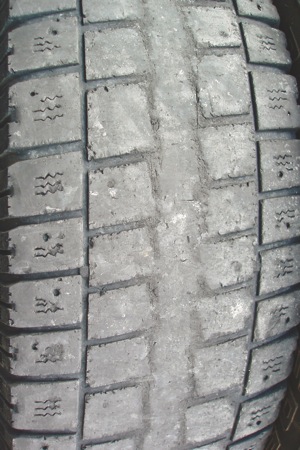
Incorrect tire pressure can aggravate any steering geometry-related tire wear complaint. The tire pressure monitoring systems required as standard equipment for the 2008 model year have gone a long way to reduce tire wear complaints. With that said, under-inflation still tends to wear both outer edges, while over-inflation tends to wear the center of the tire tread. See Photo 4.
ROAD CROWN ISSUES
Most highways are built higher at the center to expedite drainage of rainwater and melting snow. This angled road surface, commonly called road crown, will cause a RWD vehicle aligned with equal side-to-side camber and caster angles to drift to the outer edge of the roadway. In contrast, most FWD and all-wheel-drive (AWD) vehicles are not nearly as sensitive to differences or “splits” in side-to-side camber and caster angles because the driving thrust transmitted through the front wheels pulls the vehicle along the road crown.
Nevertheless, many alignment techs often “tweak” camber and caster angles on RWD vehicles to reduce steering pull on crowned roads. Keep in mind that camber angles in RWD vehicles tend to pull toward the most positive camber, while caster angles in RWD vehicles tend to pull toward the most negative caster angle.
If the front wheels have insufficient toe angle, the driver’s-side front tire will tend to wear on the inside edge, since it’s trying to steer the vehicle toward the center of the road. Conversely, if the front wheels have excessive toe angle, the right front or passenger-side front tire will tend to wear at the outer edge because it’s trying to steer the vehicle toward the center of the road.
In summary, the diagnosis of any tire wear complaint requires a thorough interview with the customer concerning the history of the vehicle and any unusual driving conditions, including how the vehicle is routinely loaded. The diagnostic process also requires a thorough knowledge of how the fixed angles, including steering axis inclination and Ackerman Effect, can affect tire wear. In most cases, unusual tire wear patterns are the result of collision damage that can’t be detected unless the steering axis inclination and turning radius or Ackerman Effect are accurately measured.
Courtesy Brake & Front End.

